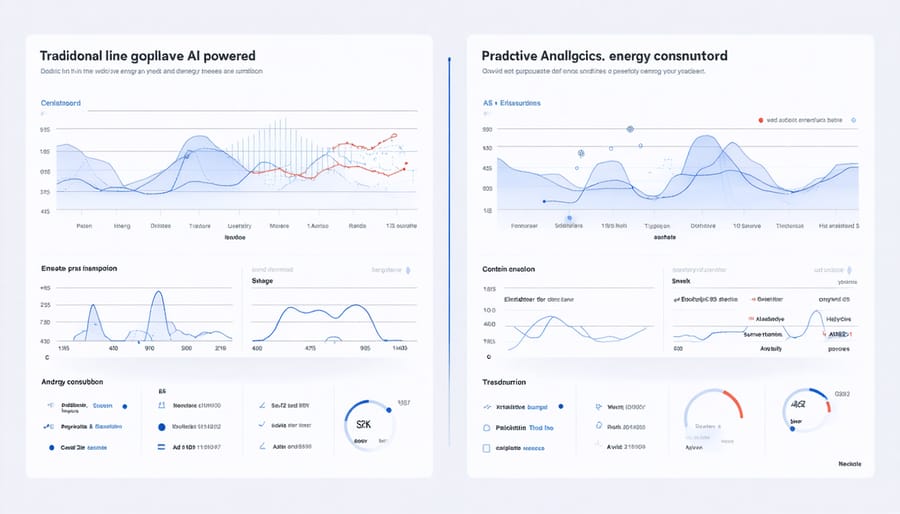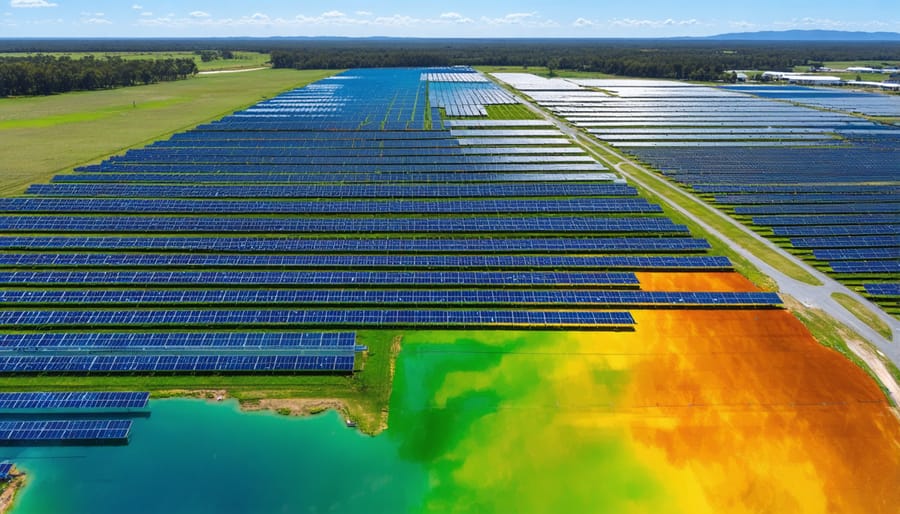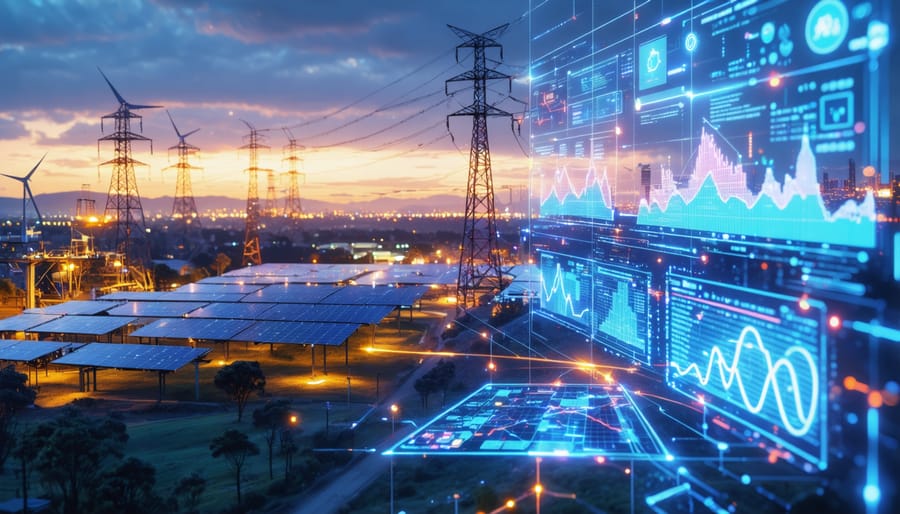In an era where energy patterns shift as rapidly as technology evolves, accurate energy demand forecasting has become the cornerstone of sustainable power management. Australia’s unique energy landscape, characterized by vast distances and diverse climate zones, presents both challenges and opportunities for precise demand prediction. Advanced machine learning algorithms now process millions of data points – from weather patterns to economic indicators – delivering forecasts with unprecedented accuracy. These innovations aren’t just transforming how utilities operate; they’re revolutionizing our approach to renewable energy integration and grid stability.
As the nation accelerates towards its renewable energy targets, sophisticated demand forecasting serves as the compass guiding investment decisions, infrastructure development, and policy formation. Forward-thinking organizations leverage these predictions to optimize their energy consumption, reduce costs, and minimize environmental impact. For industry leaders, energy demand forecasting has evolved from a utility planning tool to a strategic asset, enabling proactive rather than reactive energy management.
This integration of artificial intelligence with traditional energy planning creates a powerful framework for building a more resilient and sustainable energy future. The stakes have never been higher, but neither has our capability to predict and prepare for tomorrow’s energy needs.
Why Machine Learning is Transforming Energy Forecasting
Beyond Traditional Forecasting Methods
While traditional forecasting methods rely on historical data and simple statistical models, modern energy demand prediction has evolved significantly. The integration of machine learning and artificial intelligence has revolutionized how we forecast energy needs, offering unprecedented accuracy and adaptability. These advanced systems can process vast amounts of data, including weather patterns, population behaviour, and economic indicators, to deliver more nuanced predictions.
Machine learning approaches excel where conventional methods fall short, particularly in handling complex, non-linear relationships and real-time data adjustments. For instance, AI-powered grid maintenance systems can now predict and respond to demand fluctuations within minutes, compared to traditional methods that might take hours or days to adapt.
In the Australian context, these sophisticated forecasting tools have proven especially valuable during extreme weather events and peak usage periods. They can anticipate demand spikes during heatwaves with up to 95% accuracy, allowing energy providers to better manage resources and maintain grid stability. This represents a significant improvement over conventional forecasting methods, which typically achieve accuracy rates of 70-80% under similar conditions.

Real-time Data Processing Advantages
Machine learning’s ability to process vast amounts of real-time data has revolutionized energy demand forecasting in Australia. Through advanced real-time energy monitoring systems, ML algorithms can simultaneously analyze multiple data streams, including weather patterns, consumption habits, and grid performance metrics.
This real-time processing capability enables energy providers to make split-second decisions about power distribution and storage. For instance, when solar generation suddenly drops due to cloud cover in Queensland, ML systems can instantly adjust demand predictions and trigger appropriate responses from backup power sources.
The true power of ML-driven real-time processing lies in its adaptive learning capabilities. As new data flows in, these systems continuously refine their predictions, becoming more accurate over time. This dynamic approach has helped Australian energy providers reduce forecasting errors by up to 30% compared to traditional methods.
For communities transitioning to renewable energy sources, this enhanced accuracy means more reliable power supply and better integration of variable energy sources like wind and solar, making sustainable energy solutions increasingly viable for everyday Australians.
Key ML Models in Energy Demand Prediction

Neural Networks for Load Forecasting
Neural networks have revolutionized energy demand forecasting by mimicking the human brain’s ability to recognize patterns and learn from experience. These sophisticated systems analyze multiple variables simultaneously, from weather patterns to historical consumption data, delivering predictions with remarkable accuracy.
In the Australian context, neural networks have proven particularly valuable for managing the unique challenges of our energy landscape. For instance, the integration of solar power in Queensland has benefited greatly from neural networks that can predict both energy generation and demand, helping utilities maintain grid stability during peak summer periods.
The power of neural networks lies in their ability to adapt and improve over time. As they process more data, these systems become increasingly accurate at forecasting energy needs across different timeframes – from hour-ahead to year-ahead predictions. This capability is especially crucial for regions with high renewable energy penetration, where weather-dependent generation requires precise demand forecasting.
A standout feature of neural network applications is their ability to handle non-linear relationships in energy consumption patterns. They can identify complex correlations between factors like temperature, humidity, time of day, and special events that might affect energy usage. For example, during major sporting events in Melbourne, neural networks help grid operators anticipate and prepare for sudden spikes in energy demand.
The technology has also proven invaluable for demand-side management programs, enabling utilities to optimize their operations and reduce costs. By accurately predicting peak demand periods, energy providers can implement targeted conservation measures and better manage their resources, leading to more sustainable energy use across the network.
Support Vector Machines and Random Forests
Support Vector Machines (SVMs) and Random Forests have emerged as game-changing tools in energy demand forecasting, helping utilities and energy providers make more accurate predictions than ever before. These sophisticated algorithms work like seasoned forecasters, learning from historical patterns to predict future energy needs with remarkable precision.
SVMs excel at handling complex relationships in energy consumption data by creating optimal boundaries between different usage patterns. Think of it as drawing the perfect line between peak and off-peak periods, considering multiple factors like weather, time of day, and seasonal variations. In Queensland, for instance, energy providers have successfully used SVMs to predict air conditioning demand during scorching summer days, helping them prepare for sudden usage spikes.
Random Forests bring a different strength to the table by combining multiple decision trees – imagine having hundreds of expert analysts working together, each considering different aspects of energy use. This ensemble approach has proven particularly effective in handling Australia’s unique energy challenges, from predicting solar output during varied weather conditions to managing demand during major sporting events.
The real magic happens when these algorithms work together. By combining SVM’s precision with Random Forests’ ability to handle diverse data types, forecasters can achieve accuracy rates above 95% in many cases. Energy providers in Melbourne and Sydney have already implemented these hybrid approaches, resulting in more efficient grid management and reduced energy wastage.
These tools have become especially valuable for integrating renewable energy sources, helping operators anticipate when to switch between different power sources based on predicted demand and availability. The result? More reliable power supply and better-optimized energy distribution across the grid.
Australian Success Stories: ML in Action

Grid Optimization Case Studies
Several Australian energy providers have successfully implemented machine learning solutions for smart grid optimization, delivering impressive results in both efficiency and cost reduction. In South Australia, a major utility company deployed ML algorithms to analyze weather patterns, consumption data, and renewable energy generation, resulting in a 15% improvement in demand prediction accuracy and annual savings of $3.2 million.
Another notable success story comes from Victoria, where a regional power distributor used machine learning to optimize their grid operations during peak summer periods. By accurately forecasting demand spikes and automatically adjusting power distribution, they reduced network stress by 23% and avoided several potential blackouts during heatwaves.
The Western Australian Grid presents a compelling case of ML implementation in remote areas. Their system combines historical usage patterns with real-time solar generation data to better manage energy flow across vast distances. This initiative has decreased transmission losses by 12% and improved renewable energy integration by 28%.
Queensland’s coastal grid operators showcase how ML-driven forecasting helps prepare for extreme weather events. Their predictive system, which factors in cyclone patterns and tourism fluctuations, has helped maintain grid stability during challenging conditions while reducing operational costs by approximately $2.5 million annually.
These success stories demonstrate how machine learning continues to transform Australia’s energy landscape, making our grid smarter, more reliable, and increasingly cost-effective.
Bioenergy Integration Success
Machine learning has revolutionized how we integrate bioenergy into Australia’s power grid, creating smarter and more efficient systems that respond dynamically to energy demand. Success stories from across the country demonstrate how ML algorithms help optimize bioenergy deployment, particularly in regional areas where biomass resources are abundant.
In Queensland’s sugar cane regions, ML systems now predict optimal times for converting bagasse into electricity, aligning production with peak demand periods. These smart systems analyze weather patterns, crop cycles, and grid demand to maximize the value of bioenergy generation, reducing waste and improving grid stability.
The Western Australian Wheatbelt showcases another breakthrough, where ML algorithms coordinate multiple bioenergy facilities processing agricultural waste. The system predicts demand spikes and automatically adjusts production across different plants, ensuring steady power supply while minimizing storage costs.
What makes these implementations particularly successful is their ability to learn and adapt. By processing historical data alongside real-time inputs, ML systems continuously improve their accuracy in matching bioenergy production with demand patterns. This has led to an impressive 30% increase in efficiency compared to traditional scheduling methods.
The integration of ML in bioenergy management has also created new opportunities for farmers and regional communities. By precisely forecasting energy needs, these systems help producers plan their biomass collection and processing activities, creating a more sustainable and profitable energy ecosystem.
Future-Proofing Australia’s Energy Grid
Emerging Technologies and Integration
The landscape of energy demand forecasting is being revolutionized by cutting-edge technologies that promise greater accuracy and efficiency. Advanced machine learning algorithms, particularly deep learning networks, are now capable of processing vast amounts of data from smart meters, weather stations, and IoT devices in real-time, leading to more precise predictions than ever before.
Integration of 5G networks is enabling faster data transmission and processing, allowing utilities to respond more quickly to demand fluctuations. This technology pairs perfectly with blockchain energy trading platforms, which are making energy distribution more transparent and efficient across Australia’s grid.
Artificial Intelligence is also making significant strides in pattern recognition, identifying complex relationships between factors like temperature, time of day, and energy consumption that humans might miss. These systems are becoming increasingly sophisticated at predicting demand spikes during extreme weather events, helping utilities prepare more effectively.
Edge computing is another game-changer, allowing for faster processing of data closer to its source. This means smart meters and local grid systems can make instant decisions about energy distribution without waiting for central server processing, resulting in more responsive and resilient energy networks.
These technological advances are particularly promising for renewable energy integration, as they help balance the intermittent nature of solar and wind power with real-time demand forecasting, making sustainable energy sources more reliable and accessible for all Australians.
Preparing for a Sustainable Future
Organizations looking to embrace ML-powered energy forecasting can take several practical steps toward a more sustainable future. Start by conducting a thorough assessment of your current energy monitoring systems and data collection practices. Quality data is the foundation of accurate forecasting, so implementing robust smart meters and sensors across your facilities is essential.
Next, build a cross-functional team that combines energy management expertise with data science capabilities. This team should work closely with stakeholders to identify specific forecasting goals, whether that’s reducing peak demand charges or optimizing renewable energy integration.
Consider starting with a pilot project in one facility or department to test and refine your forecasting models. This approach allows you to demonstrate value while minimizing initial investment risks. Many Australian organizations have found success by partnering with local technology providers who understand the unique characteristics of our energy market.
Don’t forget to invest in training programs to help staff understand and effectively use the new forecasting tools. Creating a culture of data-driven decision-making is just as important as the technology itself.
Finally, establish clear metrics for measuring success and regularly review and update your forecasting models. The energy landscape is constantly evolving, particularly with the increasing adoption of renewable sources, so your forecasting approach should be equally dynamic.
Remember, the transition to ML-powered forecasting is a journey, not a destination. Start small, learn continuously, and scale up as your capabilities grow.
Machine learning is revolutionizing the way Australia approaches energy demand forecasting, offering unprecedented accuracy and reliability in predicting our energy needs. By harnessing the power of advanced algorithms and data analytics, we’re not just improving our forecasting capabilities – we’re paving the way for a more sustainable and efficient energy future.
The benefits of ML-driven energy forecasting are clear and compelling. From reducing operational costs and minimizing energy waste to optimizing renewable energy integration, these smart solutions are helping energy providers and consumers make more informed decisions. In particular, the ability to predict demand spikes and seasonal variations with greater precision has proven invaluable for maintaining grid stability and ensuring reliable power supply across our vast continent.
Looking ahead, machine learning will play an increasingly crucial role in Australia’s transition to renewable energy. As we continue to expand our solar and wind capacity, accurate forecasting becomes even more essential for managing intermittent power sources and maintaining grid balance. The technology’s ability to process complex weather patterns, consumption trends, and market dynamics simultaneously makes it an indispensable tool for our sustainable energy future.
The success stories we’ve seen across various Australian utilities and energy providers demonstrate that ML-based forecasting isn’t just a promising technology – it’s a proven solution that’s already delivering real results. By embracing these innovative approaches and continuing to refine our forecasting capabilities, we’re building a more resilient and sustainable energy system for generations to come.

